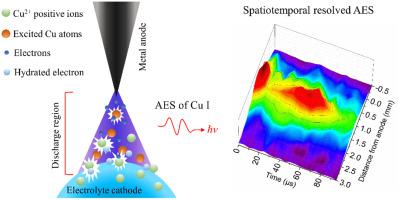Spectrochimica Acta Part B: Atomic Spectroscopy ( IF 3.3 ) Pub Date : 2021-01-16 , DOI: 10.1016/j.sab.2021.106072 Hao Yuan , Xiong-Feng Zhou , Yong Nie , Yao Li , Jian-Ping Liang , De-Zheng Yang , Er-Yan Yan , Wen-Chun Wang , Yong Xu

|
Atmospheric pressure electrolyte cathode discharge plasma presents a great potential on detecting heavy metal pollutants. In this paper, a novel microsecond pulsed electrolyte cathode discharge was generated and coupled with temporal resolved atomic emission spectra to analyze Cu element, as one of the representative heavy metals. The waveforms of voltage and current, as well as optical emission spectra of discharge were investigated, and the experimental conditions were optimized. The spatiotemporal resolved spectra of Cu I (324.8 nm), OH (A2Σ–X2Π) and N2 (C3Πu–B3Πg) were diagnosed. The spatiotemporal distributions of gas temperature and electron density were calculated by the rotational temperature of OH (A) and the Stark broadening of Hβ (486.1 nm), respectively. It was found that the optimal detection sensitivity of Cu are obtained under the conditions of HNO3 solution with 1.0 pH value, 3.0 mL/min solution flow rate, 8.5 kV pulse peak voltage, and 100 μs pulse width. The interferences of spectral line of Cu I (324.8 nm) are mainly sourced by the spectral bands of N2 (C-B) and OH (A-X), which could be reduced by the temporal resolved spectra. The limit of detection of Cu was improved from 0.217 mg/L to 0.092 mg/L by acquiring spectra only in 25–100 μs, under the optimal conditions. Furthermore, the gas temperature and electron density play important roles in the spatiotemporal evolution of discharge and the improvement of detection sensitivity for elemental analysis.
中文翻译:

脉冲电解质阴极放电的时间分辨原子发射光谱法,用于提高Cu的检测灵敏度
大气压电解质阴极放电等离子体在检测重金属污染物方面具有很大的潜力。在本文中,产生了一种新型的微秒脉冲电解质阴极放电,并与时间分辨的原子发射光谱耦合以分析作为代表性重金属之一的Cu元素。研究了电压,电流波形以及放电的光发射光谱,优化了实验条件。的Cu I(324.8纳米),的时空分辨光谱OH(A 2 Σ-X 2 Π)和N 2(C 3 Π ù -B 3 Π克)被诊断。气体温度和电子密度的时空分布通过OH(A)和斯塔克扩大H的的旋转温度来计算β(486.1纳米)分别。发现在pH值为1.0,溶液流速为3.0 mL / min,脉冲电压峰值为8.5 kV,脉冲宽度为100μs的HNO 3溶液条件下,可获得最佳的Cu检测灵敏度。Cu I(324.8 nm)光谱线的干扰主要来自N 2的光谱带(CB)和OH(AX),可以通过时间分辨光谱降低。通过在最佳条件下仅以25–100μs的时间采集光谱,Cu的检出限从0.217 mg / L提高到0.092 mg / L。此外,气体温度和电子密度在放电的时空演变和元素分析检测灵敏度的提高中起着重要作用。



























 京公网安备 11010802027423号
京公网安备 11010802027423号